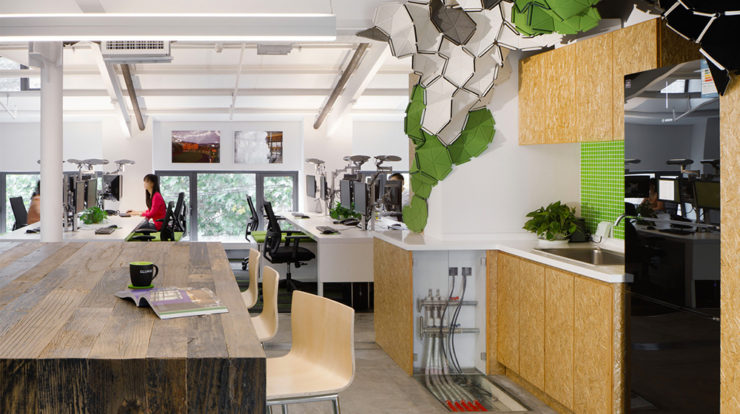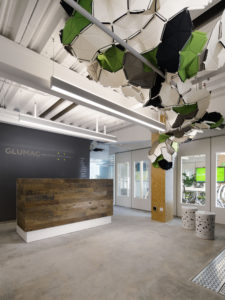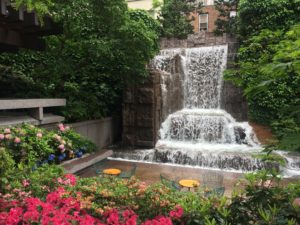

Features
New Biophilic Design Case Studies: Greenacre Park and Glumac’s Shanghai Office
Allison Bernett
Share
Learn more about our biophilic design work and services by emailing us at [email protected] and reading our reports, 14 Patterns of Biophilic Design and The Economics of Biophilia. Follow the conversation on twitter: @TerrapinBG | #14Patterns.
Perhaps you have heard about biophilia, but you’ve wondered what a biophilic space might look like? As a follow-up to our 14 Patterns of Biophilic Design and The Economics of Biophilia publications, we’ve been compiling a series of case studies on a spectrum of design projects that successfully leverage biophilic design to create healthful, restorative, or stimulating spaces.
Now, we have two more case studies to add to the growing list: a pocket park in Manhattan and an office space targeting Living Building Challenge certification in Shanghai. These two diverse projects show how versatile biophilic design is: the strategic selection and implementation of biophilic design patterns can elicit the desired health outcomes for that project, whether it is a restorative park or a stimulating workplace.
The first new case study reviews Greenacre Park in midtown Manhattan. Greenacre is another example of a “pocket park:” a small park set in a dense urban environment meant to provide a respite from the hustle and bustle of city streets. The park has a large 25 ft waterfall, honey locust trees, flowering plants, trellises, rough-hewn stone walls, and three distinct elevations for a variety of seating options.
One of our previous case studies featured Paley Park, another pocket park in Manhattan. Not surprisingly, these parks share some similarities. Both are great examples of Presence of Water: they each have large waterfalls that are central to their appeal. The waterfalls create calming sounds and cool breezes that help mask the noise and heat of the city. Also, both parks create an excellent sense of Refuge through protected seating options, obscured views to the street, and overhead tree canopies. Presence of Water is known to reduce stress, increase feelings of tranquility, and improve concentration, among other health benefits, while Refuge can improve concentration and create a sense of safety. All of these health benefits are very much needed to counteract the impacts of the stressful urban environment around them.

The entrance of Glumac’s Shanghai Office with a biomorphic Kvadrat “cloud.” Photo copyright Nobuko Ohara / Nacasa & Partners Inc.
Our other case study examines Glumac’s new office space in Shanghai, China. The office is a renovation of a historic building designed by Louis Sullivan and targets an impressive Living Building Challenge Certification for its Net Zero Energy, Net Zero Water and Net Zero Carbon design. In addition, the design team strove to create a biophilic work environment. Similar to the COOKFOX Architecture Studio and the Kickstarter Headquarters, the office has copious daylighting and views to an outdoor courtyard. Additionally, the space also sports natural materials, a green wall and indoor plants, and a biomorphic Kvadrat “cloud” of acoustic panels. Terrapin provided environmental strategy and biophilic design consulting during the design phase of the project.
This space demonstrates how biophilic design can reinforce core sustainability principles. Instead of covering up the inner workings of the design’s inventive environmental systems, the team choose to encourage the occupants to be active participants in the functioning of the building’s systems. An app shows occupants real time data on the interior air quality maintained by mechanical systems and indoor plants that filter the air. Posters around the space educate occupants about features like the greywater water system that captures rainwater and condensation for use in the restrooms and to water the indoor plants. The southern windows will turn opaque at the touch of a button. Such features not only connect occupants to natural systems, but invite them to adjust systems for continual improvement and efficiency.
82% of employees reported that the design elements of the Glumac office space facilitated their productivity.”
The success of the biophilic interventions shows: In a survey of employees, 82% reported that the design elements of the office space facilitated their productivity, and 91% said that the design elements lightened their mood during work.
Click the links below to read both case studies:
- Glumac Shanghai Office, Gensler, Shanghai, China – PDF (2 MB)
- Greenacre Park, Hideo Sasaki, New York, NY – PDF (5 MB)
Want more? View and download all of our biophilic design case studies here.
*Header image copyright Nobuko Ohara / Nacasa & Partners Inc.
Filed under:
Allison Bernett
Allison Bernett is an associate project manager and the public relations coordinator for Terrapin Bright Green. She graduated summa cum laude from Washington University in St. Louis with a double major in architecture and biology. Allison’s interests focus on architecture, sustainability, and bioinspired innovation.
Topics
- Occupant Comfort
- Materials Science
- Speaking
- LEED
- Terrapin Team
- Phoebe
- Community Development
- Greenbuild
- Technology
- Biophilic Design Interactive
- Catie Ryan
- Spanish
- Hebrew
- French
- Portuguese
- Publications
- Carbon Neutrality
- Environmental Values
- Conference
- Psychoacoustics
- Education
- Workshop
- Mass Timber
- Transit
- Carbon Strategy
- connection with natural materials
- interior design
- inspirational hero
- biophilia
- economics of biophilia
- Sustainability
- Systems Integration
- Biophilic Design
- Commercial
- Net Zero
- Resorts & Hospitality
- Energy Utilization
- Water Management
- Corporations and Institutions
- Institutional
- Ecosystem Science
- Green Guidelines
- Profitability
- Climate Resiliency
- Health & Wellbeing
- Indoor Environmental Quality
- Building Performance
- Bioinspired Innovation
- Biodiversity
- Residential
- Master Planning
- Architects and Designers
- Developers and Building Owners
- Governments and NGOs
- Urban Design
- Product Development
- Original Research
- Manufacturing
- Industrial Ecology
- Resource Management
- Sustainability Plans
- Health Care



